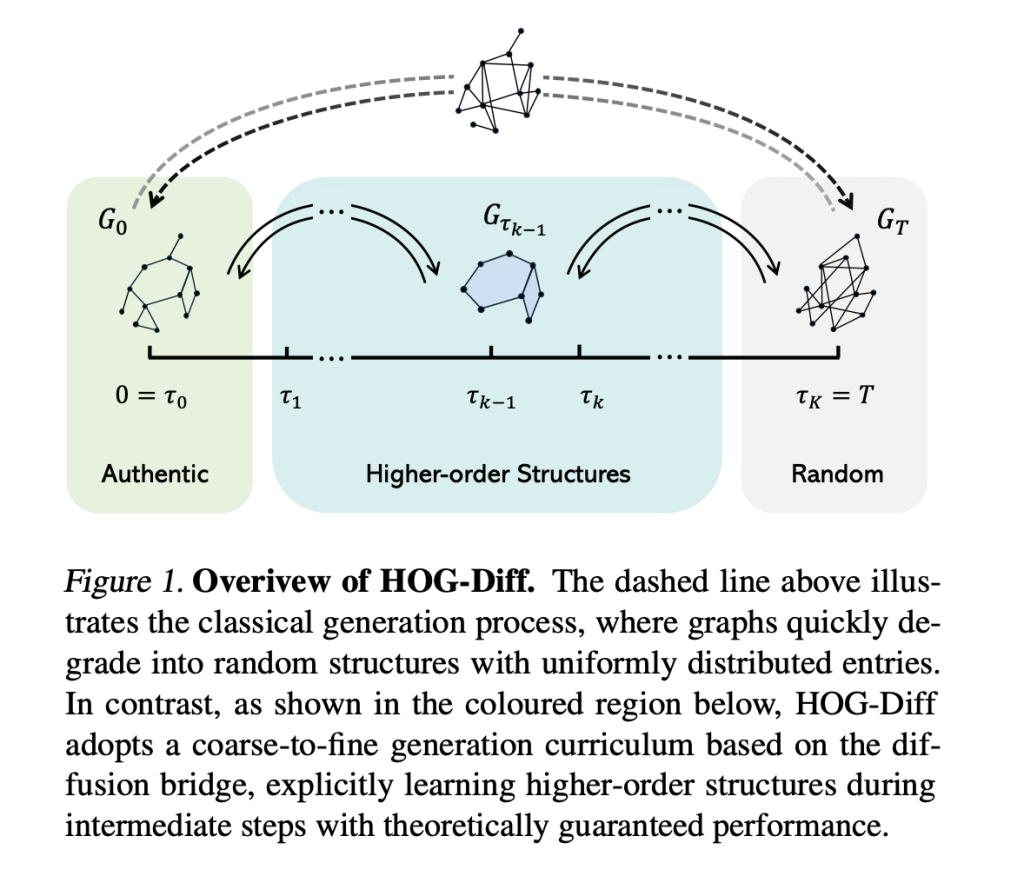

Graph generation is a complex problem that involves constructing structured, non-Euclidean representations while maintaining meaningful relationships between entities. Most current methods fail to capture higher-order interactions, like motifs and simplicial complexes, required for molecular modeling, social network analysis, and protein design applications. Diffusion-based methods, first developed for image synthesis, have been popularized widely in the application domain but tend to lose important topological information. The rapid decay of structural dependencies throughout diffusion leads to unrealistic graph outputs. Second, traditional methods add isotropic Gaussian noise to adjacency matrices, which destroys key properties like sparsity and connectivity. To overcome these issues, an approach with higher-order structural guidance throughout graph generation is needed to preserve higher topological integrity.
Current models for graph generation are based on methods like recurrent neural networks, variational autoencoders, and generative adversarial networks. While such methods can learn structural properties, they are computationally expensive and lack scalability. Recently, diffusion-based frameworks have been proposed that improve graphs step by step progressively. While such models provide some improvement, they are inherently designed for continuous image data and thus fail to capture graphs’ discrete and hierarchical nature. One major weakness of current methods is the destruction of meaningful structure in adjacency matrices after a few steps of diffusion, resulting in random, unrealistic representations of graphs. Further, the models are often not equivariant because they fail to preserve consistency when permuting nodes, leading to an inaccurate estimation of graph distributions.
To address these challenges, HOG-Diff introduces a systematic approach based on a coarse-to-fine learning paradigm that progressively refines graphs in a way that maintains critical topological features. By decoupling the generation process into successive steps, the method first builds higher-order graph skeletons followed by the refinement of pairwise relations and intricate details. An intermediate-stage diffusion bridge mechanism maintains properly organized intermediate steps and realistic intermediate representations without any loss of detailed topological features. In contrast to traditional approaches, which act by manipulating adjacency matrices, this paradigm leverages spectral diffusion with noise injection in the eigenvalue space of the Laplacian matrix. This process damps excessive modification of connectivity patterns, leading to more structurally coherent outputs. Additionally, the model architecture uses graph convolutional networks integrated with graph transformer networks to learn localized relationships and global dependencies to enable improved model performance in general.
The generative process uses a structured multi-stage architecture where each stage refines the graph without eliminating its higher-order features. Elimination of unhelpful nodes and edges through a filtering process using cell complexes is utilized to enable this controlled graph construction. The diffusion process is controlled by a Generalized Ornstein-Uhlenbeck bridge, ensuring through mathematical means a smooth transition from one structural arrangement to another. Spectral diffusion replaces the traditional method of noise injection in the adjacency matrix by injecting perturbations into the eigenvalue space of the Laplacian matrix, preserving important connectivity and sparsity patterns. The model architecture provides a balance between the preservation of local and global structure by using the integration of graph convolutional and transformer networks for the capture of informative features across scales.
Large-scale experimentation verifies that HOG-Diff attains better performance than state-of-the-art approaches on both molecular and generic graph generation tasks. In the context of applications in molecular space, this model performs to a remarkable degree in major similarity measures, such as lower Neighborhood Subgraph Pairwise Distance Kernel and Fréchet ChemNet Distance scores, thus reflecting higher consistency with realistic molecular distributions. Higher validity, uniqueness, and novelty scores further demonstrate its capability to generate chemically meaningful structures. Apart from the specific context of molecular graphs, the model also demonstrates unparalleled capability in abstracting complex topological dependencies in generic datasets, attaining lower error rates in degree distribution, clustering coefficient, and orbit structure accuracy. Maintenance of higher-order features during generative transformation leads to generating graphs that not only attain realism but are also structurally stable, providing a more reliable solution than existing practices.
With the integration of higher-order structural information directly into the generative model, HOG-Diff offers an improved solution for graph synthesis overcoming the limitations of traditional diffusion models. The integration of a coarse-to-fine generation strategy, diffusion bridge operations, and spectral diffusion ensures the generated graphs maintain topological fidelity and semantic correctness. Large-scale evaluation on diverse datasets confirms its capability to generate high-quality graphs with improved structural correctness. Systematic exploration of diverse topological guides improves explainability, making this framework a valuable tool in applications from drug discovery and urban modeling to network science. Maintenance of advanced graph structures, this method demonstrates an important advance in deep generative modeling over structured data.
Check out the Paper. All credit for this research goes to the researchers of this project. Also, feel free to follow us on Twitter and don’t forget to join our 75k+ ML SubReddit.
The post Higher-Order Guided Diffusion for Graph Generation: A Coarse-to-Fine Approach to Preserving Topological Structures appeared first on MarkTechPost.
Source: Read MoreÂ



 Recommended Open-Source AI Platform: ‘IntellAgent is a An Open-Source Multi-Agent Framework to Evaluate Complex Conversational AI System’ (Promoted)
Recommended Open-Source AI Platform: ‘IntellAgent is a An Open-Source Multi-Agent Framework to Evaluate Complex Conversational AI System’ (Promoted)
